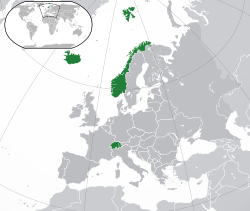
Back Europese Vryhandelsvereniging Afrikaans Europäische Freihandelsassoziation ALS رابطة التجارة الحرة الأوروبية Arabic Avropa Sərbəst Ticarət Birliyi Azerbaijani Еўрапейская асацыяцыя свабоднага гандлю Byelorussian Европейска асоциация за свободна търговия Bulgarian Associació Europea de Lliure Comerç Catalan Evropské sdružení volného obchodu Czech EFTA Danish Europäische Freihandelsassoziation German
European Free Trade Association Native names:
| |
|---|---|
 Location of the EFTA (green) in Europe (green & dark grey) | |
| Secretariat | Geneva 46°57′N 7°27′E / 46.950°N 7.450°E |
| Largest city | Oslo 59°56′N 10°41′E / 59.933°N 10.683°E |
| Official working language | English |
| Official languages of member states | |
| Type | Regional organization, Free-trade area |
| Member states | |
| Leaders | |
• Secretary General | Henri Gétaz |
• Council Chair | Iceland[2] |
| Establishment | |
• Convention signed | 4 January 1960 |
• Established | 3 May 1960 |
| Area | |
• Total | 529,600 km2 (204,500 sq mi) |
| Population | |
• 2020 estimate | 14,400,000[3] |
• Density | 26.5/km2 (68.6/sq mi) |
| GDP (PPP) | 2020 estimate |
• Total | $1.0 trillion[3] |
• Per capita | $70,000 |
| GDP (nominal) | 2020 estimate |
• Total | $1.1 trillion[3] |
• Per capita | $79,000 |
| Currency | |
| Time zone | |
• Summer (DST) | UTC+2 (CEST) |
| Note: Iceland observes WET all year, while Liechtenstein, Norway and Switzerland observe CET and CEST. | |
Website efta | |
The European Free Trade Association (EFTA) is a regional trade organization and free trade area consisting of four European states: Iceland, Liechtenstein, Norway and Switzerland.[4] The organization operates in parallel with the European Union (EU), and all four member states participate in the European Single Market and are part of the Schengen Area.[5] They are not, however, party to the European Union Customs Union.
EFTA was historically one of the two dominant western European trade blocs, but is now much smaller and closely associated with its historical competitor, the European Union. It was established on 3 May 1960 to serve as an alternative trade bloc for those European states that were unable or unwilling to join the then European Economic Community (EEC), the main predecessor of the EU. The Stockholm Convention (1960), to establish the EFTA, was signed on 4 January 1960 in the Swedish capital by seven countries (known as the "outer seven": Austria, Denmark, Norway, Portugal, Sweden, Switzerland and the United Kingdom).[6] A revised Convention, the Vaduz Convention, was signed on 21 June 2001 and entered into force on 1 June 2002.[7]
After 1995 only two founding members remained, namely Norway and Switzerland. The other five, Austria, Denmark, Portugal, Sweden and the United Kingdom, had joined the EU at some point in the intervening years. The initial Stockholm Convention was superseded by the Vaduz Convention, which aimed to provide a successful framework for continuing the expansion and liberalization of trade, both among the organization's member states and with the rest of the world.
While the EFTA is not a customs union and member states have full rights to enter into bilateral third-country trade arrangements, it does have a coordinated trade policy.[4] As a result, its member states have jointly concluded free trade agreements with the EU and a number of other countries.[4] To participate in the EU's single market, Iceland, Liechtenstein, and Norway are parties to the Agreement on a European Economic Area (EEA), with compliances regulated by the EFTA Surveillance Authority and the EFTA Court. Switzerland has a set of multilateral agreements with the EU and its member states instead.[dubious ]
- ^ "Láhkasánit - Saamelaiskäräjät" (PDF). Sámi Parliament of Finland. Retrieved 29 August 2019.
- ^ "Chairmanship". efta.int. EFTA. July 2020.
- ^ a b c "Report for Selected Countries and Subjects". imf.org.
- ^ a b c "1949-Bulletin-10-Web" (PDF). Retrieved 8 May 2017.
- ^ "The European Free Trade Association". efta.int. Retrieved 12 December 2014.
- ^ "EFTA through the years". efta.int. 2014. Retrieved 13 April 2019.
- ^ "The EFTA Convention | European Free Trade Association". www.efta.int.
© MMXXIII Rich X Search. We shall prevail. All rights reserved. Rich X Search
